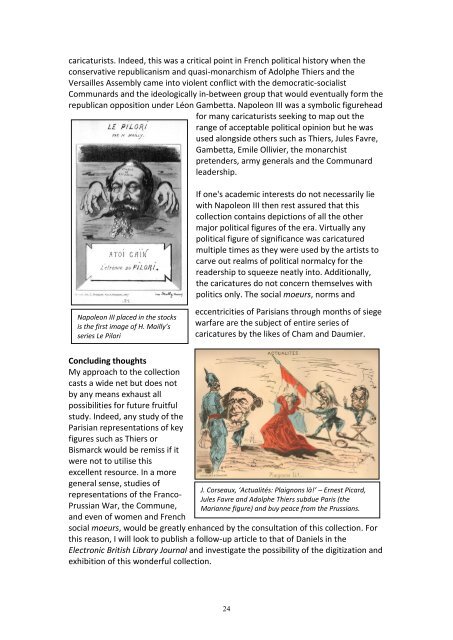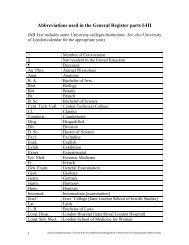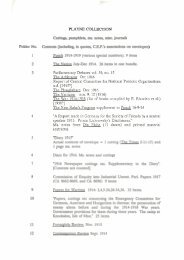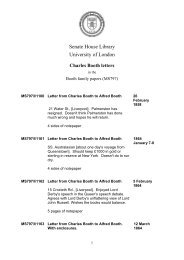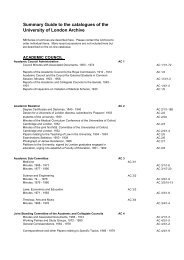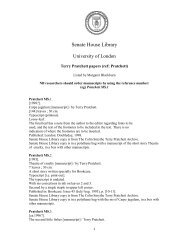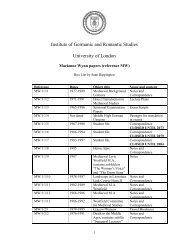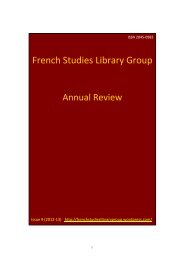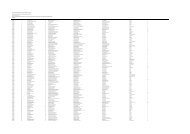FSLG Annual Review - Senate House Libraries - University of London
FSLG Annual Review - Senate House Libraries - University of London
FSLG Annual Review - Senate House Libraries - University of London
Create successful ePaper yourself
Turn your PDF publications into a flip-book with our unique Google optimized e-Paper software.
caricaturists. Indeed, this was a critical point in French political history when the<br />
conservative republicanism and quasi-monarchism <strong>of</strong> Adolphe Thiers and the<br />
Versailles Assembly came into violent conflict with the democratic-socialist<br />
Communards and the ideologically in-between group that would eventually form the<br />
republican opposition under Léon Gambetta. Napoleon III was a symbolic figurehead<br />
for many caricaturists seeking to map out the<br />
range <strong>of</strong> acceptable political opinion but he was<br />
used alongside others such as Thiers, Jules Favre,<br />
Gambetta, Emile Ollivier, the monarchist<br />
pretenders, army generals and the Communard<br />
leadership.<br />
If one's academic interests do not necessarily lie<br />
with Napoleon III then rest assured that this<br />
collection contains depictions <strong>of</strong> all the other<br />
major political figures <strong>of</strong> the era. Virtually any<br />
political figure <strong>of</strong> significance was caricatured<br />
multiple times as they were used by the artists to<br />
carve out realms <strong>of</strong> political normalcy for the<br />
readership to squeeze neatly into. Additionally,<br />
the caricatures do not concern themselves with<br />
politics only. The social moeurs, norms and<br />
Napoleon III placed in the stocks<br />
is the first image <strong>of</strong> H. Mailly’s<br />
series Le Pilori<br />
eccentricities <strong>of</strong> Parisians through months <strong>of</strong> siege<br />
warfare are the subject <strong>of</strong> entire series <strong>of</strong><br />
caricatures by the likes <strong>of</strong> Cham and Daumier.<br />
Concluding thoughts<br />
My approach to the collection<br />
casts a wide net but does not<br />
by any means exhaust all<br />
possibilities for future fruitful<br />
study. Indeed, any study <strong>of</strong> the<br />
Parisian representations <strong>of</strong> key<br />
figures such as Thiers or<br />
Bismarck would be remiss if it<br />
were not to utilise this<br />
excellent resource. In a more<br />
general sense, studies <strong>of</strong><br />
representations <strong>of</strong> the Franco-<br />
Prussian War, the Commune,<br />
and even <strong>of</strong> women and French<br />
J. Corseaux, ‘Actualités: Plaignons là!’ – Ernest Picard,<br />
Jules Favre and Adolphe Thiers subdue Paris (the<br />
Marianne figure) and buy peace from the Prussians.<br />
social moeurs, would be greatly enhanced by the consultation <strong>of</strong> this collection. For<br />
this reason, I will look to publish a follow-up article to that <strong>of</strong> Daniels in the<br />
Electronic British Library Journal and investigate the possibility <strong>of</strong> the digitization and<br />
exhibition <strong>of</strong> this wonderful collection.<br />
24


